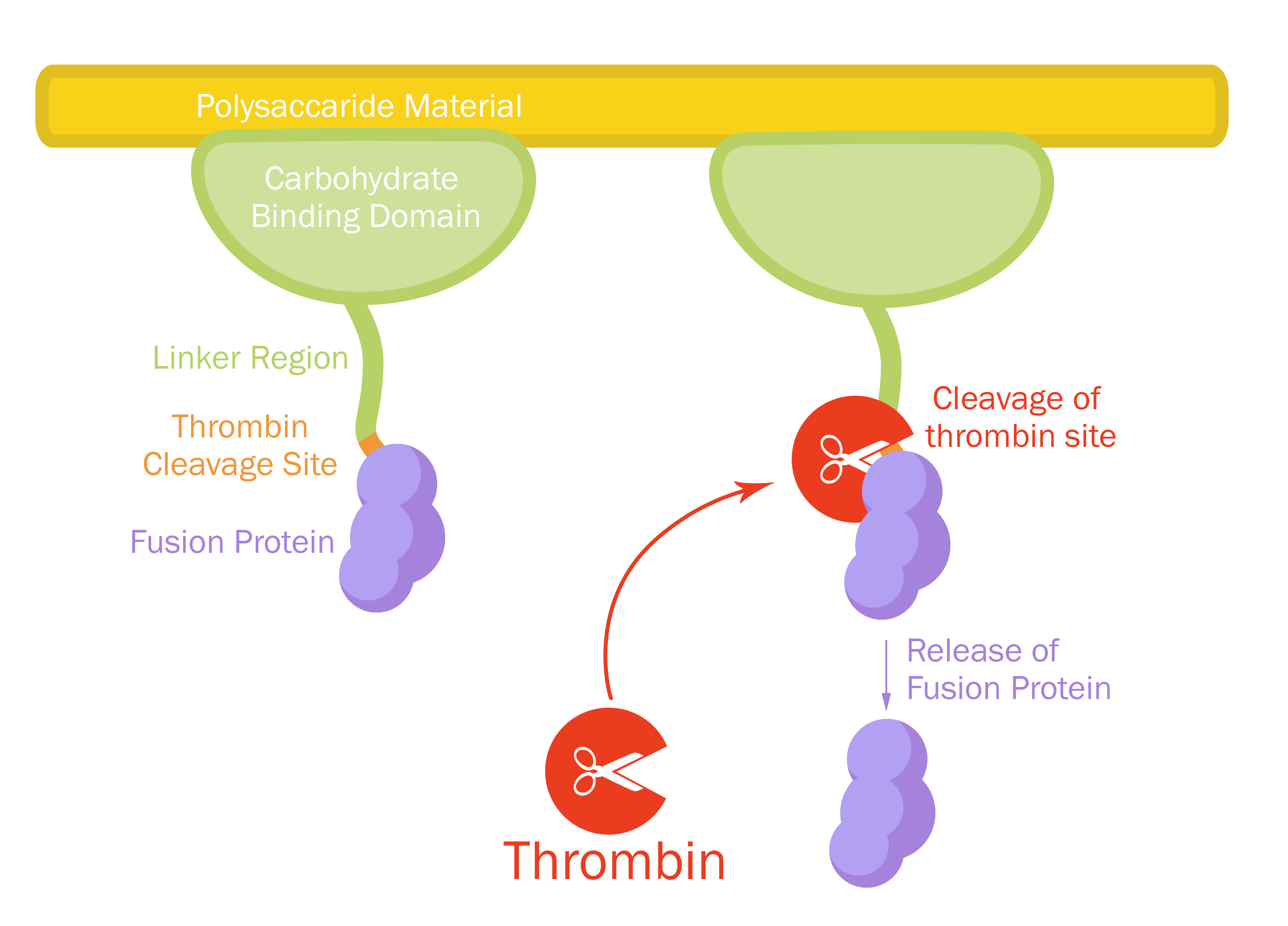Part:BBa_K3182104
Contents
Sequence and Features
- 10COMPATIBLE WITH RFC[10]
- 12COMPATIBLE WITH RFC[12]
- 21INCOMPATIBLE WITH RFC[21]Illegal BamHI site found at 580
- 23COMPATIBLE WITH RFC[23]
- 25COMPATIBLE WITH RFC[25]
- 1000COMPATIBLE WITH RFC[1000]
Introduction
pT7-CBDcipA-LysK

This part consists of a carbohydrate binding domain (CBD) from Clostridium thermocellum (C. thermocellum) cellulose scaffolding protein (CipA). This binding domain is a central part of Clostridium thermocellum's cellusome and has a strong affinity for cellulose. The CBD was fused to another protein using a flexible GS-linker (-GGGGSGGGGS-)in order to attach this complex to a polysaccaride material. A thrombin cleavage site (-LVPRGS-) was added to the end of the linker and its breakage will leave a glycine and serine attached to the N-terminal of the fusion protein.
Protease site and use
The thrombin site was added to enable the ability to release the fusion protein down into skin wounds. Thanks to our integrated human practice we learned that infections span much deeper into wounds that we thought. Simply attaching the CBD-fusion protein to a carbohydrate material would not enable the fusion protein to reach far into the wound. The thrombin site was also chosen because of thrombin's endogenous existence in humans.
Assembly compabilities
An internal BamHI recognition sequence (RS) has been added to enable interchangeable fusion proteins to the CBD. BamHI was chosen because its RS codes for glycine and serine, fitting it to the end of the thrombin site. It is also a cost-effective enzyme and is unaffected by methylated DNA. BamHI is a part of the RFC21 standard.
CBDcipA crystal structure
Important molecular faces
CBDcipA is composed of a nine-stranded beta sandwich with a jelly roll topology and binds a calcium ion. It further contains conserved residues exposed on the surface which map into two clear surfaces on each side of the molecule. One of the faces mainly contains planar strips of aromatic and polar residues which may be the carbohydrate binding part. Further aspects are unknown and unique to this CBD such as the other conserved residues which are contained in a groove.
Carbohydrate binding domain specificity
Since the CBD is from the cellusome of C. thermocellum some research labeled it a cellulose binding domain. However, iGEM19 Linköping noticed that this domain could also bind to different sources of polysaccaride materials. This serves as a domain for iGEM19 Linköpings modular bandage, where the polysaccaride material can be exchanged for other/similar materials and not exclusively cellulose.
The choice of carbohydrate binding domain
iGEM Linköping 2019 chose CBDcipA due to the fact that many other iGEM teams had explored the possibilities of this domain. Our basic design was influenced by [http://2014.igem.org/Team:Imperial iGEM14 Imperial], [http://2015.igem.org/Team:edinburgh iGEM15 Edinburgh] and [http://2018.igem.org/Team:ecuador iGEM18 Ecuador]. Purification and where to place the fusion protein (N- or C-terminal) was determined by studying the former projects. CBDcipA also originates from a thermophilic bacteria which further increases the domain's applications.
Expression system
The part has a very strong expression with a T7-RNA-polymerase promotor (BBa_I719005) as well as a 5'-UTR (BBa_K1758100) region which has been shown to further increase expression in E. coli (BBa_K1758106), ([http://www.ncbi.nlm.nih.gov/pubmed/2676996 Olins et al. 1989]), ([http://www.ncbi.nlm.nih.gov/pubmed/23927491 Takahashi et al. 2013]).
Figure B. Benchling screenshot of the expression system. The T7-RNA-polymerase promotor is followed by a T7 g10 leader sequence which enhances the binding to the 16S ribosomal RNA. After the leader sequence a poly A spacer is found, which has been shown to increase translation in vitro. Before the start codon a strong RBS, g10-L, followed by an AT-rich spacer can be seen, which will slightly increase translation of the following gene.]]Antimicrobial Agent - LysK
Bacteriophage endolysins digest the peptidoglycan wall of bacteria. The LysK is an endolysin targeting gram+ bacteria. It has two catalytical domains known as CHAP (cysteine-and histidine dependent amidohydrolase/peptidase) and a central amidase-2 domain together with a cell binding domain. The CHAP domain which is the truncated part expressed in this year’s LiU iGEM (more specifically CHAP C1-C162) team still has lytic activity against staphylococcus. The C1 to C162 amino acids are required for full endopeptidase activity. The purpose of the truncation is to increase the antimicrobial effect of CHAP, decrease its risk of immunological response and increase protein yield.
The endolysin is designed to battle the Enterococcus faecium, Staphylococcus aureus, Klebsiella pneumoniae, Acinetobacter baumannii, Pseudomonas aeruginosa, Enterobacter spp. family of pathogens (ESKAPE). ESKAPE is a family(ies) of bacteria which has multiple understrains that has evolved resistance to the most commonly used antibiotics.
Expression, purification and protease treatment
The antimicrobial agents which iGEM19 Linköping used were all expressed the same way. Early expression experiments showed great promise but with low yields. The early experiments were done with standard E. coli BL21 (DE3) expression, cultures were grown to an optical density at 600 nm (OD600) of 0.4-1.0 in varying volumes and induced with 0.5 mM IPTG, and let to express the agents for 16 hours in 18 °C. Harvest of the cells was done at 3500 rpm for 30 minutes.
Solubilization and thrombin treatment
After harvest the cells was re-suspended in phosphate buffered saline (PBS, 137 mM NaCl, 2.7 mM KCl, 10 mM Na2HPO4, 1.8 mM KH2PO4) buffer or carbohydrate binding module buffer (CBM-buffer, Tris–HCl pH 7.0, 20 mM NaCl, 5 mM CaCl2) and sonicated for 6 minutes, 30 % amplitude and 30 seconds on, 30 seconds off. The sonicated bacteria was then centrifuged at 12000 g for 15 minutes. Because of the low yield from the soluble fraction, a detergent (Triton X100, 1 %) was used to re-suspend the lipid-soluble proteins (insoluble fraction).
Thrombin treatment
These bound fractions could also be cleaved with thrombin, where 25 units Bovine Thrombin (100 µL) by Sigma Aldrich was added. To this thrombin cleavage buffer (20 mM Tris-HCl, 150 mM NaCl and 2.5 mM CaCl2) was also added (500 µL) along with deionized water (4.4 mL). The cellulose bound fraction was discarded and the supernatant, with thrombin and the now unbound antimicrobial agent, was saved for later use.
Antimicrobial activity of CHAP
Sequence and Features
| None |





